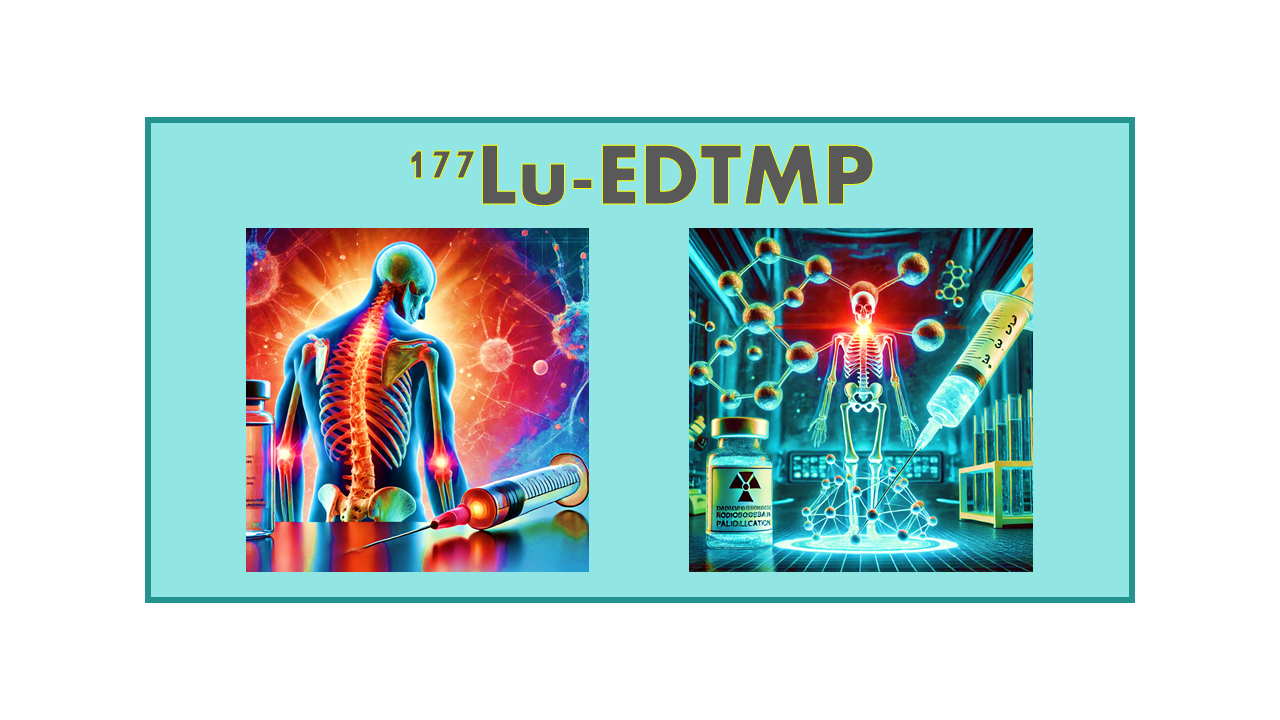
177Lu-EDTMP
December 27, 2024
What is 177Lu-EDTMP?
177Lu-EDTMP (Lutetium-177 ethylenediaminetetramethylene phosphonate) is a radiopharmaceutical therapy developed for bone pain palliation in cancer patients, specifically those with bone metastases, such as from prostate cancer. It serves as an alternative to 153Sm-EDTMP (Lexidronam), commonly known as Quadramet®, which was widely used for the same indication.
Although 153Sm-EDTMP is now available as a generic, 177Lu-EDTMP has gained popularity in regions where 153Sm-EDTMP was either unavailable or prohibitively expensive. By utilizing Lutetium-177 instead of Samarium-153, 177Lu-EDTMP offers a cost-effective solution, bypassing the intellectual property (IP) limitations of Quadramet®.
Clinical Applications of 177Lu-EDTMP
177Lu-EDTMP is primarily indicated for bone pain palliation in patients with cancer-related bone metastases, most commonly prostate cancer. It works by delivering targeted radiation to metastatic bone lesions, helping alleviate pain caused by cancer spreading to the bones.
The International Atomic Energy Agency (IAEA) has played a significant role in supporting the development of 177Lu-EDTMP. The IAEA sponsored a multicenter clinical trial to validate the efficacy and safety of this treatment, further promoting its use in regions where affordable options for cancer pain relief are needed.
Availability
177Lu-EDTMP is commercially available from several manufacturers, including Pars Isotope under the name Lu-177 EDTMP and BRIT (Board of Radiation and Isotope Technology) offering it as LUK-1 and LUM-1. The Lutetium-177 used in the production of 177Lu-EDTMP is carrier-added and produced via the direct route, ensuring a steady supply for medical applications.
Competition in the Market
177Lu-EDTMP enters a competitive market for bone pain palliation therapies, joining a range of other radiopharmaceuticals such as:
- 32P (Phosphorus-32)
- 153Sm-EDTMP (Lexidronam)
- 188Re-HEDP (Rhenium-188 hydroxyethylidene diphosphonate)
- 223Ra-Chloride (Radium-223 dichloride)
While no head-to-head clinical studies have been conducted to determine the superiority of one radiopharmaceutical over another, the overall efficacy for bone pain palliation appears to be similar across these options. Therefore, factors such as cost per dose, regional availability, and reimbursement policies play a key role in determining which therapy is chosen in clinical settings.
Key Considerations and Market Dynamics
The development of 177Lu-EDTMP with support from the IAEA highlights important issues regarding competition between government-backed products and those developed by private pharmaceutical companies. On one hand, the availability of affordable radiopharmaceuticals, especially in developing countries, is a positive outcome. However, it also raises concerns among investors in the private sector.
Government-backed products, such as 177Lu-EDTMP, can enter the market with lower development costs and fewer regulatory hurdles, creating competition that doesn’t require the same level of financial investment as privately developed treatments. This dynamic has led to a growing reluctance among private investors to fund radiopharmaceutical research and development, as the risk of competing with government-sponsored products may outweigh the potential rewards.
The Future of 177Lu-EDTMP and Radiopharmaceutical Development
For the future of radiopharmaceuticals like 177Lu-EDTMP, clear regulatory guidelines are needed to balance the roles of government bodies and private industry. Establishing transparent rules that outline the conditions under which governments will not interfere with private investments could encourage renewed interest in the field. Without such safeguards, private investors may continue to shy away from radiopharmaceutical development, potentially slowing innovation in this critical area of cancer treatment.
In conclusion, while 177Lu-EDTMP represents a significant advancement in affordable cancer pain management, its development raises important questions about the future of competition and investment in radiopharmaceuticals. Balancing access to affordable treatments with encouraging private sector involvement will be crucial to ensuring continued progress in this field.